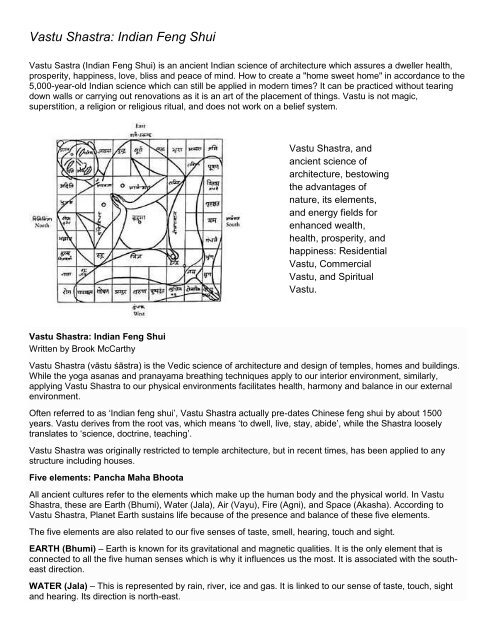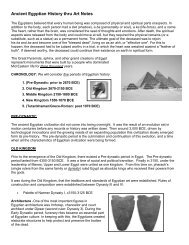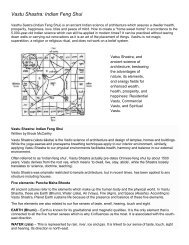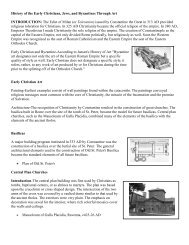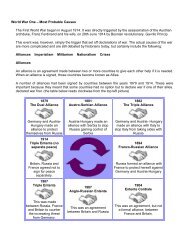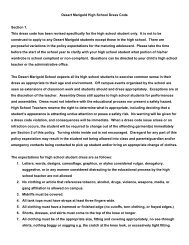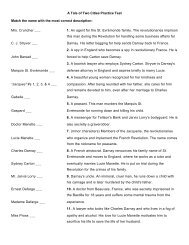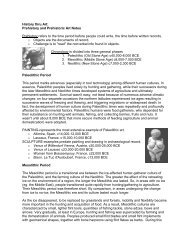Indian notes.pdf - DMHScommunity
Indian notes.pdf - DMHScommunity
Indian notes.pdf - DMHScommunity
Create successful ePaper yourself
Turn your PDF publications into a flip-book with our unique Google optimized e-Paper software.
Vastu Shastra: <strong>Indian</strong> Feng ShuiVastu Sastra (<strong>Indian</strong> Feng Shui) is an ancient <strong>Indian</strong> science of architecture which assures a dweller health,prosperity, happiness, love, bliss and peace of mind. How to create a "home sweet home" in accordance to the5,000-year-old <strong>Indian</strong> science which can still be applied in modern times? It can be practiced without tearingdown walls or carrying out renovations as it is an art of the placement of things. Vastu is not magic,superstition, a religion or religious ritual, and does not work on a belief system.Vastu Shastra, andancient science ofarchitecture, bestowingthe advantages ofnature, its elements,and energy fields forenhanced wealth,health, prosperity, andhappiness: ResidentialVastu, CommercialVastu, and SpiritualVastu.Vastu Shastra: <strong>Indian</strong> Feng ShuiWritten by Brook McCarthyVastu Shastra (vāstu śāstra) is the Vedic science of architecture and design of temples, homes and buildings.While the yoga asanas and pranayama breathing techniques apply to our interior environment, similarly,applying Vastu Shastra to our physical environments facilitates health, harmony and balance in our externalenvironment.Often referred to as ‘<strong>Indian</strong> feng shui’, Vastu Shastra actually pre-dates Chinese feng shui by about 1500years. Vastu derives from the root vas, which means ‘to dwell, live, stay, abide’, while the Shastra looselytranslates to ‘science, doctrine, teaching’.Vastu Shastra was originally restricted to temple architecture, but in recent times, has been applied to anystructure including houses.Five elements: Pancha Maha BhootaAll ancient cultures refer to the elements which make up the human body and the physical world. In VastuShastra, these are Earth (Bhumi), Water (Jala), Air (Vayu), Fire (Agni), and Space (Akasha). According toVastu Shastra, Planet Earth sustains life because of the presence and balance of these five elements.The five elements are also related to our five senses of taste, smell, hearing, touch and sight.EARTH (Bhumi) – Earth is known for its gravitational and magnetic qualities. It is the only element that isconnected to all the five human senses which is why it influences us the most. It is associated with the southeastdirection.WATER (Jala) – This is represented by rain, river, ice and gas. It is linked to our sense of taste, touch, sightand hearing. Its direction is north-east.
AIR (Vayu) – The air on earth is a mixture of various gases such as nitrogen, oxygen, helium, and hydrogen,which are essential for humans, so air is fundamental to our survival. Air relates to our sense of sound andtouch and is associated with the north-west direction.FIRE (Agni) – Associated with the sun, fire represents light and heat which accounts for day and night, theseasons, vitality, enthusiasm, passion and strength. The element of fire is related to our sense of sound, touchand sight, and its direction is south-east.SPACE (Akasha) – Space is infinite with no boundaries. It is linked to our sense of hearing and related to thecentral position, known as brahmasthan.Applying Vastu in your homeEach direction is governed by a planet and each intermediate direction relates to one of the elements. So, forexample, north is ruled by the planet Mercury while south-east is associated with the element fire. So an idealposition for the fireplace or kitchen of a house is the south-east corner.The fire element rules good health, sound finances and familial happiness, so the south-east corner of everyroom should include a spotlight or lantern with the light pointing towards the ceiling. Electricals such as thetelevision, fridge, computer, microwave, etc, can be placed in the south-east corners.The central part of a house is ruled by the space element. As all directions meet in the centre, it is holiest andmost powerful zone of the house. Ideally, it should be kept open and uncluttered so that light can illuminate thecentre. Traditionally, houses in India used to have an open courtyard in the center of the house, providing opensky, sunlight and cross-ventilation.Air should enter a building from north-east. There are various guidelines for placement of doors, windows,ventilators, balconies, trees and plants, to balance the air element. Bodies of water bodies in the north or eastare considered good. The flow and drain of water should be towards the north-east.Best sleeping positionThe direction that your head points while lying in bed is important. Our bodies have a positive north- andnegative south-charged pole. It is best to avoid sleeping with our heads directed north because, as with amagnet, the two positive poles repel each other. Sleeping with the head towards the west is also not advisable.Sleeping with the head towards the south is highly recommended, bringing sound sleep and increasing thewealth and prosperity of the household. Sleeping with your head resting in the east enhances memory, healthand spiritual inclination so it is often advised for children.


